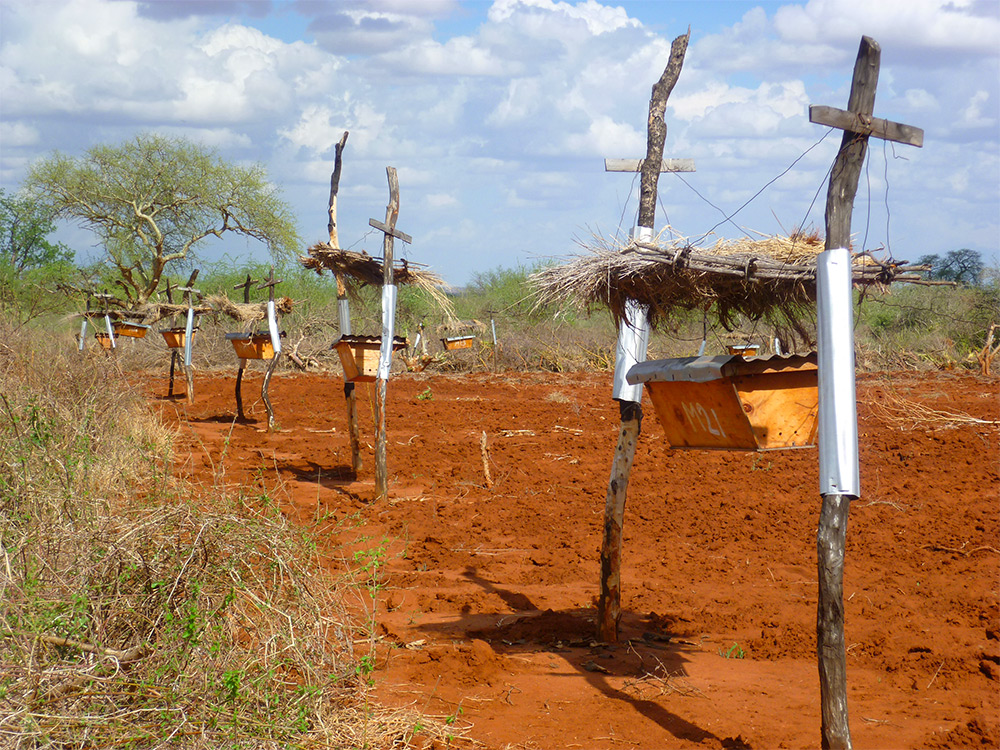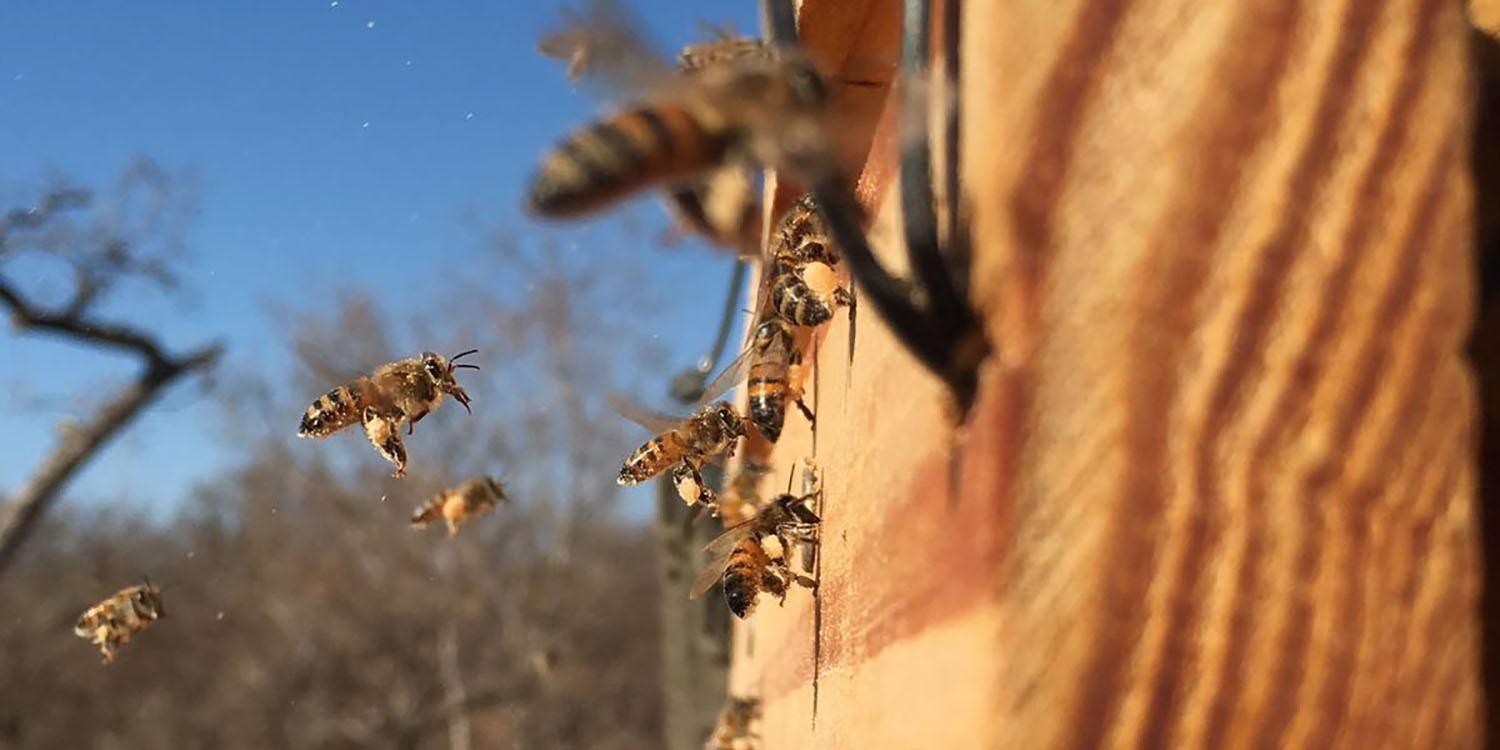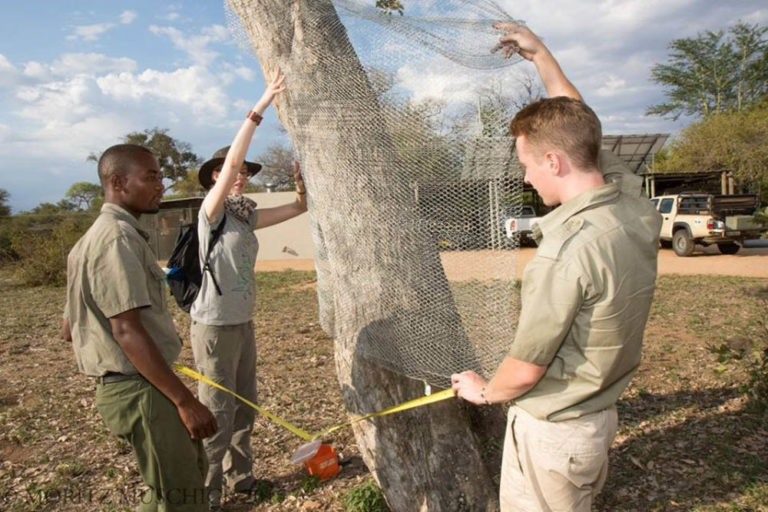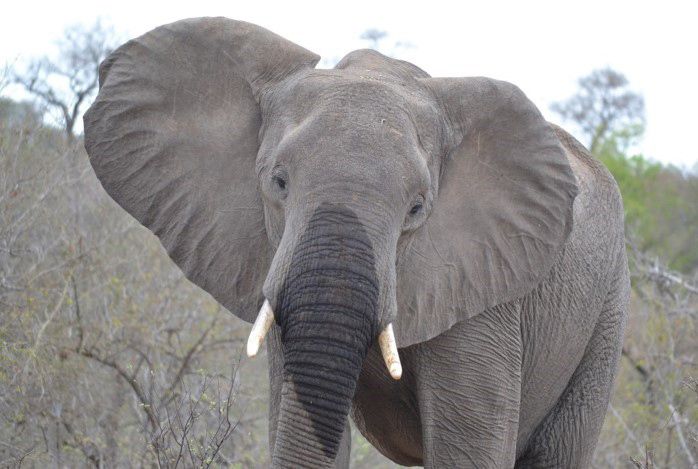WATCH: Why the Kruger Park enlisted bees to protect its trees from marauding elephants
2018-06-22 17:55
https://youtu.be/csNPDHxjxBo
The Bees and the Elephants - How to Deter Elephants from Damaging Big Trees
- Lisbeth
- Site Admin
- Posts: 67160
- Joined: Sat May 19, 2012 12:31 pm
- Country: Switzerland
- Location: Lugano
- Contact:
The Bees and the Elephants - How to Deter Elephants from Damaging Big Trees
"Education is the most powerful weapon which you can use to change the world." Nelson Mandela
The desire for equality must never exceed the demands of knowledge
The desire for equality must never exceed the demands of knowledge
- Richprins
- Committee Member
- Posts: 75988
- Joined: Sat May 19, 2012 3:52 pm
- Location: NELSPRUIT
- Contact:
Re: South Africa: The Bees and the Elephants
How elephants’ fear of bees could benefit them and humans where their habitats overlap
The threat of bees is so intensely felt by elephants that conservationists in Kenya are using it to help prevent the kinds of conflict that put these animals at risk.
19 hours ago
Amanda Coetzee
Researchers in South Africa’s Greater Kruger National Park proved that African elephants are afraid of honeybees.
They hope to use this trait locally as a strategy to keep elephants away from human-populated areas, reported Live Science. The researchers published their study in the journal Current Biology.
Honeybees release pheromones when they sense a threat. These pheromones act as a natural alarm signal calling members of the hive to assist in the defense of the hive by stinging. Scientists realized that if elephants could sense the alarm pheromones from honeybees, they’d likely keep their distance from that area.
To test this theory, the researchers placed a sock filled with a slow-release matrix containing a blend of honeybee alarm pheromones near a watering hole frequented by the park’s elephants. They watched 25 of 29 elephants approach the sock and briefly inspect it from a distance before backing away in fear.
Researchers think elephants are afraid of bees because they dislike being stung in the soft tissue inside their trunks and around their eyes. They surmise that as the elephants evolved, they learned to identify the alarm pheromones and to steer clear of honeybees to avoid their painful stings.
Strategies to prevent conflict and loss of elephants
Human populations are growing in regions of Africa and Asia that overlap with elephant habitat, making it important to develop safe elephant-management strategies that will help prevent conflict and the loss of elephants.
https://youtu.be/SAHK-V3F4rU
The threat of bees is so intensely felt by elephants that conservationists in Kenya are using it to help prevent the kinds of conflict that put these animals at risk.
Watch: Elephants also run from the sound of bees
https://youtu.be/jjDKNtFG0V8
The New York Times reported that researchers persuaded farmers in Africa to use elephants’ fear of bees as a fence line to protect crops. By stringing beehives every 20 meters – alternating with fake hives – a team of researchers have shown that they can keep 80 percent of elephants away from farmland.
Save the Elephants, a nonprofit conservationist group, builds wire and beehive fences at a cost of about $1,000 for a one-acre farm, said Dr. Lucy King, who heads the human-elephant coexistence programme for the charity. The farm gets protection against elephants and a modest new source of income from a twice-a-year honey harvest.

Another study led by Dr King, who is an Oxford University research associate, found that Asian elephants are also afraid of bees, though perhaps less so. It’s the first step toward showing that the control strategy can also work in countries like Sri Lanka, India, Nepal and Thailand, where Asian elephants are 10 times more endangered than their African cousins.
https://lowvelder.co.za/470840/elephant ... s-overlap/
The threat of bees is so intensely felt by elephants that conservationists in Kenya are using it to help prevent the kinds of conflict that put these animals at risk.
19 hours ago
Amanda Coetzee
Researchers in South Africa’s Greater Kruger National Park proved that African elephants are afraid of honeybees.
They hope to use this trait locally as a strategy to keep elephants away from human-populated areas, reported Live Science. The researchers published their study in the journal Current Biology.
Honeybees release pheromones when they sense a threat. These pheromones act as a natural alarm signal calling members of the hive to assist in the defense of the hive by stinging. Scientists realized that if elephants could sense the alarm pheromones from honeybees, they’d likely keep their distance from that area.
To test this theory, the researchers placed a sock filled with a slow-release matrix containing a blend of honeybee alarm pheromones near a watering hole frequented by the park’s elephants. They watched 25 of 29 elephants approach the sock and briefly inspect it from a distance before backing away in fear.
Researchers think elephants are afraid of bees because they dislike being stung in the soft tissue inside their trunks and around their eyes. They surmise that as the elephants evolved, they learned to identify the alarm pheromones and to steer clear of honeybees to avoid their painful stings.
Strategies to prevent conflict and loss of elephants
Human populations are growing in regions of Africa and Asia that overlap with elephant habitat, making it important to develop safe elephant-management strategies that will help prevent conflict and the loss of elephants.
https://youtu.be/SAHK-V3F4rU
The threat of bees is so intensely felt by elephants that conservationists in Kenya are using it to help prevent the kinds of conflict that put these animals at risk.
Watch: Elephants also run from the sound of bees
https://youtu.be/jjDKNtFG0V8
The New York Times reported that researchers persuaded farmers in Africa to use elephants’ fear of bees as a fence line to protect crops. By stringing beehives every 20 meters – alternating with fake hives – a team of researchers have shown that they can keep 80 percent of elephants away from farmland.
Save the Elephants, a nonprofit conservationist group, builds wire and beehive fences at a cost of about $1,000 for a one-acre farm, said Dr. Lucy King, who heads the human-elephant coexistence programme for the charity. The farm gets protection against elephants and a modest new source of income from a twice-a-year honey harvest.

Another study led by Dr King, who is an Oxford University research associate, found that Asian elephants are also afraid of bees, though perhaps less so. It’s the first step toward showing that the control strategy can also work in countries like Sri Lanka, India, Nepal and Thailand, where Asian elephants are 10 times more endangered than their African cousins.
https://lowvelder.co.za/470840/elephant ... s-overlap/
Please check Needs Attention pre-booking: https://africawild-forum.com/viewtopic.php?f=322&t=596
- Lisbeth
- Site Admin
- Posts: 67160
- Joined: Sat May 19, 2012 12:31 pm
- Country: Switzerland
- Location: Lugano
- Contact:
Re: South Africa: The Bees and the Elephants
Surprising! 

"Education is the most powerful weapon which you can use to change the world." Nelson Mandela
The desire for equality must never exceed the demands of knowledge
The desire for equality must never exceed the demands of knowledge
- Lisbeth
- Site Admin
- Posts: 67160
- Joined: Sat May 19, 2012 12:31 pm
- Country: Switzerland
- Location: Lugano
- Contact:
Re: The Bees and the Elephants
Beehive fences can help mitigate human-elephant conflict
by Hannah Thomasy on 11 September 2019
- Crop-raiding by elephants can devastate small farmers, leading to food insecurity, lost opportunity costs, and even death, as well as negative attitudes towards elephants, but finding effective and inexpensive solutions has proven extremely difficult.
- Beehive fences—surrounding crops fields with beehives attached to fence posts and strung together with wires—may serve as a humane and eco-friendly way to protect crops from elephants.
- Repeated farm-level trials have demonstrated benefits to farmers of using beehive fences, including fewer elephants approaching their fields and, for communities willing to manage the bees, production of “elephant-friendly” honey. However, the strategy doesn’t work everywhere: it requires management by farmers and willingness of bees to occupy at least some of the hives, and appropriate length and positioning to dissuade elephants from just walking around them.
- Beehive fences have benefited farmers in several East African countries, and projects elsewhere have begun to test them as well, but several uncertainties, including their success at a scale that doesn’t just displace the elephants to the first unfenced farm, suggest they should still be used with other techniques as part of a toolkit to reduce human-elephant conflict.
Click on the title in order to read the whole article with photos!
by Hannah Thomasy on 11 September 2019
- Crop-raiding by elephants can devastate small farmers, leading to food insecurity, lost opportunity costs, and even death, as well as negative attitudes towards elephants, but finding effective and inexpensive solutions has proven extremely difficult.
- Beehive fences—surrounding crops fields with beehives attached to fence posts and strung together with wires—may serve as a humane and eco-friendly way to protect crops from elephants.
- Repeated farm-level trials have demonstrated benefits to farmers of using beehive fences, including fewer elephants approaching their fields and, for communities willing to manage the bees, production of “elephant-friendly” honey. However, the strategy doesn’t work everywhere: it requires management by farmers and willingness of bees to occupy at least some of the hives, and appropriate length and positioning to dissuade elephants from just walking around them.
- Beehive fences have benefited farmers in several East African countries, and projects elsewhere have begun to test them as well, but several uncertainties, including their success at a scale that doesn’t just displace the elephants to the first unfenced farm, suggest they should still be used with other techniques as part of a toolkit to reduce human-elephant conflict.
Click on the title in order to read the whole article with photos!
"Education is the most powerful weapon which you can use to change the world." Nelson Mandela
The desire for equality must never exceed the demands of knowledge
The desire for equality must never exceed the demands of knowledge
- Lisbeth
- Site Admin
- Posts: 67160
- Joined: Sat May 19, 2012 12:31 pm
- Country: Switzerland
- Location: Lugano
- Contact:
Re: The Bees and the Elephants
Why don't they use this system in Botswana? It needs a bit of goodwill and help from "know-how" organisations, but if they don't try.....  Or is it all a political game?
Or is it all a political game?
"Education is the most powerful weapon which you can use to change the world." Nelson Mandela
The desire for equality must never exceed the demands of knowledge
The desire for equality must never exceed the demands of knowledge
- Lisbeth
- Site Admin
- Posts: 67160
- Joined: Sat May 19, 2012 12:31 pm
- Country: Switzerland
- Location: Lugano
- Contact:
Re: The Bees and the Elephants - How to Deter Elephants from damaging big Trees
Pungent potions deployed to stop elephant tree-muggers
By Tony Carnie for Roving Reporters• 19 November 2019

Bees return to their hive, suspended beneath a tree to deter elephants (Photo: Scott Chui)
Elephants have been described as ‘nature’s ecological engineers’, and can fundamentally alter the landscapes around them as they forage, damaging or killing large trees. Now researchers are experimenting with smelly solutions to the problem.
Elephants can topple or damage very large trees when feeding on their bark, roots, branches or sweet wild fruit.
But private landowners next to the Kruger National Park have some tricks up their sleeves. They are experimenting with several surprise “weapons” to deter the hungry behemoths from damaging certain iconic trees – including a smelly paste of fermented elephant dung that is smeared over the trunks of these large trees.

Chicken wire netting is wrapped around large and iconic trees to deter bark-stripping. (Photo: Robin Cook and Moritz Muschick)
“There is anecdotal evidence that animals avoid feeding too close to where they defecate,” says Robin Cook, the Big Tree projects manager of the Hoedspruit-based Elephants Alive research and conservation group.
Cook and senior colleague Dr Michelle Henley presented some of their recent elephant management research work to fellow scientists and conservation managers at the annual Conservation Symposium in Howick, KwaZulu-Natal, on 6 November 2019.

Creosotes stain the trunk of an elephant. (Photo: Ronny Makukule)
Henley, the co-founder of Elephants Alive, noted that elephant bulls can excrete up to 150kg of dung per day, helping to fertilise the soil and to disperse seeds up to 65km away during their daily foraging trips.
The acids in an elephant’s digestive tract also help to soften and promote the germination of certain tree seeds, which are then excreted in fertile parcels of rich mulch containing semi-digested plant matter.

Sharp rocks placed around the base of large trees help to deter hungry elephants. (Photo: Robin Cook)
However, as much as elephants play a crucial role in shaping nature through the propagation of large trees such as marula (Sclerocarya birrea), knobthorn (Senegalia nigrescens) and red bushwillow (Combretum apiculatum), they also knock down, damage or ring-bark mature specimens, causing extensive damage to vegetation in the vicinity of regular watering holes.
To limit damage to certain vulnerable or iconic tree species in fenced-off conservation areas, Elephants Alive has been researching the cost-effectiveness of a wide variety of non-lethal tree protection methods, mainly on privately-owned wildlife reserves next to Kruger National Park under the umbrella of the Association of Private Nature Reserves.

Dr Michelle Henley. (Photo: Tony Carnie)
Cook says much of this work has centred around marula trees, a species that reaches heights of 18m and produces a sweet-tasting fruit rich in vitamin C.
Some of these methods are surprisingly simple – and cheap.
For example, sheets of metal chicken-wire netting can be wrapped around the trunk of a tree to reduce damage from bark-stripping by elephants, at a cost of R100 per tree.

Robin Cook. (Photo: Tony Carnie)
To ensure that this cage of wire netting does not strangle the tree as it grows, an extra length of the netting is pinned to the tree trunk during installation, so that it can be stretched out and adjusted periodically as the tree circumference expands.
Monitoring tests suggested that only 2% of trees protected by wire netting suffered from elephant bark-stripping compared to 32% of the control specimens with no wire netting.
Another cheap and simple solution – first developed by conservation managers in the Kruger National Park – is to place several sharp, triangular-shaped shards of rock around the circumference of trees, to a distance of up to 5m from the stem.
This “rock pyramid” deterrent is also based on anecdotal evidence that elephants will avoid potential pain or injury to their sensitive foot pads and rather move on to unprotected trees.
Cook said research by Elephants Alive showed that 60% of the 80 monitored trees that were protected by rock pyramids were still alive after 13 years.
Some landowners have also been experimenting with a variety of smelly deterrents.
This has included fermenting elephant and buffalo dung, according to tree researcher Riaan van Zyl, who first started using the method in Botswana. The paste is then smeared over tree trunks.
“We will be testing whether adding hot chilli extracts to the mixture will spice things up a bit and lead to greater avoidance by elephants,” said Henley.
Though cheap, the effectiveness of this method has not been determined yet and may also be limited by the need to smear fresh coatings of dung onto trees on a regular basis as the smell fades.
Cook said he became aware of another smelly deterrent in 2017, when some reserve managers started placing creosote in open, glass jars and tin cans which are affixed to tree trunks.
Creosote is a thick and toxic dark-brown liquid derived from crude oil or coal which is often used to preserve outdoor timber from termites and other wood-eating insects.
While this method enjoyed brief success and popularity on some reserves, Cook said that Elephants Alive asked for it to be discontinued as the method was not effective and a number of elephants have been seen with creosote stains on their trunks and foreheads after accidentally dislodging the jars and cans placed on tree trunks.
Other odour experiments still under way include neem oil, again first suggested by Van Zyl.
One of the most successful deterrents so far, Cook said, involves suspending one or more bee hives on tree branches.
This deterrent is based on several research projects outside the Kruger Park and has also been used by subsistence farmers in other parts of Africa and Asia to protect their crops. Using bees to protect crops was extensively tested by Dr Lucy King.
Cook told the Howick symposium that only 8% of trees protected with bee hives were damaged by elephants, compared to 80% of control trees.
Though this method costs between R600 and R5,000 per tree, some of the costs could be recouped through the sale of eco-friendly honey produced in the hives.
A new bee-deterrent experiment was due to start shortly. This research would involve compounds derived from honeybee “attack” pheromones.
Elephants Alive researchers have partnered with Professor Mark Wright (University of Hawaii at Mānoa) and Transfrontier Africa to investigate the potential of honeybee alarm pheromones to deter wild and semi-captive elephants. The synthetic alarm pheromone experiment is known as SPLAT (Specialised Pheromone and Lure Application Technology) and will explore the potential for synthetically produced semiochemical blends of honeybee attack pheromones using iso-amyl acetate and 2-heptatone compounds.
The experiments are based on evidence that honeybees release a specific pheromone when attacking, and that elephants have an acute sense of smell and fear of bees, leading to their avoidance of areas with either bees or potentially their pheromones.
By Tony Carnie for Roving Reporters• 19 November 2019

Bees return to their hive, suspended beneath a tree to deter elephants (Photo: Scott Chui)
Elephants have been described as ‘nature’s ecological engineers’, and can fundamentally alter the landscapes around them as they forage, damaging or killing large trees. Now researchers are experimenting with smelly solutions to the problem.
Elephants can topple or damage very large trees when feeding on their bark, roots, branches or sweet wild fruit.
But private landowners next to the Kruger National Park have some tricks up their sleeves. They are experimenting with several surprise “weapons” to deter the hungry behemoths from damaging certain iconic trees – including a smelly paste of fermented elephant dung that is smeared over the trunks of these large trees.

Chicken wire netting is wrapped around large and iconic trees to deter bark-stripping. (Photo: Robin Cook and Moritz Muschick)
“There is anecdotal evidence that animals avoid feeding too close to where they defecate,” says Robin Cook, the Big Tree projects manager of the Hoedspruit-based Elephants Alive research and conservation group.
Cook and senior colleague Dr Michelle Henley presented some of their recent elephant management research work to fellow scientists and conservation managers at the annual Conservation Symposium in Howick, KwaZulu-Natal, on 6 November 2019.

Creosotes stain the trunk of an elephant. (Photo: Ronny Makukule)
Henley, the co-founder of Elephants Alive, noted that elephant bulls can excrete up to 150kg of dung per day, helping to fertilise the soil and to disperse seeds up to 65km away during their daily foraging trips.
The acids in an elephant’s digestive tract also help to soften and promote the germination of certain tree seeds, which are then excreted in fertile parcels of rich mulch containing semi-digested plant matter.

Sharp rocks placed around the base of large trees help to deter hungry elephants. (Photo: Robin Cook)
However, as much as elephants play a crucial role in shaping nature through the propagation of large trees such as marula (Sclerocarya birrea), knobthorn (Senegalia nigrescens) and red bushwillow (Combretum apiculatum), they also knock down, damage or ring-bark mature specimens, causing extensive damage to vegetation in the vicinity of regular watering holes.
To limit damage to certain vulnerable or iconic tree species in fenced-off conservation areas, Elephants Alive has been researching the cost-effectiveness of a wide variety of non-lethal tree protection methods, mainly on privately-owned wildlife reserves next to Kruger National Park under the umbrella of the Association of Private Nature Reserves.

Dr Michelle Henley. (Photo: Tony Carnie)
Cook says much of this work has centred around marula trees, a species that reaches heights of 18m and produces a sweet-tasting fruit rich in vitamin C.
Some of these methods are surprisingly simple – and cheap.
For example, sheets of metal chicken-wire netting can be wrapped around the trunk of a tree to reduce damage from bark-stripping by elephants, at a cost of R100 per tree.

Robin Cook. (Photo: Tony Carnie)
To ensure that this cage of wire netting does not strangle the tree as it grows, an extra length of the netting is pinned to the tree trunk during installation, so that it can be stretched out and adjusted periodically as the tree circumference expands.
Monitoring tests suggested that only 2% of trees protected by wire netting suffered from elephant bark-stripping compared to 32% of the control specimens with no wire netting.
Another cheap and simple solution – first developed by conservation managers in the Kruger National Park – is to place several sharp, triangular-shaped shards of rock around the circumference of trees, to a distance of up to 5m from the stem.
This “rock pyramid” deterrent is also based on anecdotal evidence that elephants will avoid potential pain or injury to their sensitive foot pads and rather move on to unprotected trees.
Cook said research by Elephants Alive showed that 60% of the 80 monitored trees that were protected by rock pyramids were still alive after 13 years.
Some landowners have also been experimenting with a variety of smelly deterrents.
This has included fermenting elephant and buffalo dung, according to tree researcher Riaan van Zyl, who first started using the method in Botswana. The paste is then smeared over tree trunks.
“We will be testing whether adding hot chilli extracts to the mixture will spice things up a bit and lead to greater avoidance by elephants,” said Henley.
Though cheap, the effectiveness of this method has not been determined yet and may also be limited by the need to smear fresh coatings of dung onto trees on a regular basis as the smell fades.
Cook said he became aware of another smelly deterrent in 2017, when some reserve managers started placing creosote in open, glass jars and tin cans which are affixed to tree trunks.
Creosote is a thick and toxic dark-brown liquid derived from crude oil or coal which is often used to preserve outdoor timber from termites and other wood-eating insects.
While this method enjoyed brief success and popularity on some reserves, Cook said that Elephants Alive asked for it to be discontinued as the method was not effective and a number of elephants have been seen with creosote stains on their trunks and foreheads after accidentally dislodging the jars and cans placed on tree trunks.
Other odour experiments still under way include neem oil, again first suggested by Van Zyl.
One of the most successful deterrents so far, Cook said, involves suspending one or more bee hives on tree branches.
This deterrent is based on several research projects outside the Kruger Park and has also been used by subsistence farmers in other parts of Africa and Asia to protect their crops. Using bees to protect crops was extensively tested by Dr Lucy King.
Cook told the Howick symposium that only 8% of trees protected with bee hives were damaged by elephants, compared to 80% of control trees.
Though this method costs between R600 and R5,000 per tree, some of the costs could be recouped through the sale of eco-friendly honey produced in the hives.
A new bee-deterrent experiment was due to start shortly. This research would involve compounds derived from honeybee “attack” pheromones.
Elephants Alive researchers have partnered with Professor Mark Wright (University of Hawaii at Mānoa) and Transfrontier Africa to investigate the potential of honeybee alarm pheromones to deter wild and semi-captive elephants. The synthetic alarm pheromone experiment is known as SPLAT (Specialised Pheromone and Lure Application Technology) and will explore the potential for synthetically produced semiochemical blends of honeybee attack pheromones using iso-amyl acetate and 2-heptatone compounds.
The experiments are based on evidence that honeybees release a specific pheromone when attacking, and that elephants have an acute sense of smell and fear of bees, leading to their avoidance of areas with either bees or potentially their pheromones.
"Education is the most powerful weapon which you can use to change the world." Nelson Mandela
The desire for equality must never exceed the demands of knowledge
The desire for equality must never exceed the demands of knowledge


